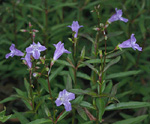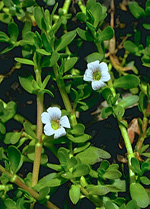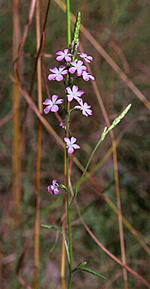 |
This is a very large family, occurring almost throughout the world but most common in open, especially moist habitats at temperate latitudes of both hemispheres, poorly represented in the tropics and deserts. This world-wide preference for temperate habitats is matched in Australia where, although members of the family may be found almost anywhere, they are most common in the south-eastern temperate region in open, moist forests, swampy areas, alpine herbfields and disturbed sites.
Characteristic features of the family Scrophulariaceae in Australia include: - herbs, sometimes rather shrubby (Derwentia), usually with opposite, simple, toothed or divided leaves and often with glandular-sticky hairs
- flowers bisexual, often showy, varying from almost regular (Veronica, Verbascum) to strongly zygomorphic, sometimes with a spurred corolla, usually yellow, blue or purple and often with lines, spots or blotches of colour to guide pollinators
- stamens usually 2 or 4, paired and unequal in length with specialised anthers, sometimes (in regular flowers) 5
- ovary superior, developing into an often flattened, 2-valved capsule more or less enclosed by the persistent calyx; seeds usually numerous, often finely sculptured
Description
Annual, biennial or perennial herbs; rarely evergreen shrubs, or woody
or herbaceous vines climbing by twining stems or petioles, or aquatic
herbs rooted in the substrate with their leaves submerged or emergent,
or rarely partially parasitic on other plants, attached to the roots of
the host. Leaves rarely absent. Perennating by rhizomes, stolons, taproots
or crowns. Vegetative reproduction absent, or by rhizomes or stolons.
Extra-floral nectaries absent, or rarely on the leaves. Stem internodes
solid or rarely spongy, pithy or hollow, ±terete, angled or winged.
Internal secretions not obvious. Plants glabrous, or with simple, dendritic,
clavate, capitate or vesicular glandular or non-glandular, unicellular
or uniseriate hairs. Leaves well developed, or rarely much reduced (i.e.
to scales, etc.), spiral or opposite, rarely in whorls of 3–5, cauline,
basally clustered, or both basally clustered and cauline, petiolate, subsessile
or sessile. Stipules absent. Lamina simple, symmetric, rarely pinnatifid,
pinnatisect, palmatifid, palmatisect, bipinnatifid, tripinnatifid, etc,
subulate, ovate, lanceolate, elliptic, oblong, obovate, spathulate, reniform
or orbicular, rarely linear; leaf base cuneate, attenuate, rounded, cordate
or auriculate; margins entire, crenate, dentate, serrate or sinuate, ±flat
or revolute; venation not obvious, 1-veined, pinnate, or palmate, or rarely
parallel, with the midrib conspicuous or inconspicuous, and the tertiary
venation reticulate or absent; surfaces not punctate, or dark- or translucent-punctate;
herbaceous, leathery or succulent; distinctive odour absent or aromatic,
or rarely foetid. Domatia absent, or rarely consisting of pits. All the
flowers bisexual. Inflorescences axillary, terminal or rarely leaf opposed,
consisting of racemes, panicles, thyrses, heads or solitary flowers, or
rarely apparently of spikes or umbels. Bracts and bracteoles absent or
present. Pollination by insects. Flowers odourless or fragrant, sessile
or stalked. Floral disc absent or present; nectaries absent, or present
on the disc or the carpels. Perianth of 2 dissimilar whorls, or very rarely
of one whorl and sepaline. Calyx regular or irregular; segments free or
fused, with (3–) 4–5 sepals or lobes, imbricate or rarely valvate, fused
into a distinct tube or cup, or fused at extreme base only; calyx cup-shaped,
bell-shaped, urceolate or tubular, herbaceous, leathery, succulent or
papery; base without or rarely with wings or other appendages. Corolla
regular or irregular; segments fused into a distinct tube or cup, or fused
at the very base only, rarely some segments fused, others free, or all
fused into a split tube, with (3–) 4–5 petals or lobes, alternating with
the sepals or calyx lobes or with no clear relationship to the sepals
or calyx lobes, imbricate in bud; corolla wheel-shaped, cup-shaped, bell-shaped,
urn-shaped, funnel-shaped, salver-shaped, rarely 1 or 2-lipped, with palate,
curved-tubular or straight, white, cream, yellow, pink, purple, magenta,
violet, blue, or rarely grey or brown, without contrasting markings, or
streaked, spotted, rarely bicoloured, membranous; petal claws absent;
lobes ±entire or notched, ciliate, emarginate, hooded, bifid or
bilobed; basal appendages none, or of spurs, or pouches. Fertile stamens
(2–) 4 (–5), opposite to or with no clear relationship with the sepals
or calyx lobes, entirely free of or fused to the corolla, or coherent
by their anthers, ±equal, or unequal. Staminodes absent, or rarely
present. Anthers dorsifixed or basifixed, rarely apicifixed; not versatile;
opening inwards or terminally by pores, or short or longitudinal slits,
1- or 2-celled; appendages absent or basal. Ovary superior and sessile.
Carpels 2, fused; ovary with (1–) 2 locules. Style terminal, single and
unbranched, or branched above with the stigma conical, clavate, fimbriate
or lamellate. Ovules 20–numerous per locule, ±stalked; placentation
axile or rarely free-central. Fruit a dehiscent or rarely indehiscent,
dry or rarely fleshy capsule with septicidal, loculicidal, poricidal or
rarely with circumscissile or operculate dehiscence; the perianth on the
maturing fruit dry and persistent or growing larger. Disseminule macro-surface
±featureless or rarely winged; micro-surface ±smooth or
rarely tuberculate, papillate, reticulate, alveolate, rugose rarely verrucose,
cream, yellow, brown, grey or black, rarely white, without contrasting
markings, glossy or dull. Seeds 10–numerous per fruit. Aril absent. Cotyledons
2. Embryo straight or curved.
(Note: this description has been generated from the coded data compiled for the key. Any errors in the key data will be reflected in the descriptions.)
A treatment of the family Scrophulariaceae has not yet been published in the Flora of Australia. It will appear in Volume 32.
Australian genera of Scrophulariaceae (as recognised for the Flora of Australia)
† = some species native, others introduced
* = all species introduced
Adenosma
Angelonia
Artanema
*Asarina
†Bacopa
*Bellardia
Buchnera
*Calceolaria
*Celsia
Centranthera
Chionohebe
*Cymbalaria
Derwentia
*Digitalis
*Dischisma
Dopatrium
Elacholoma
Euphrasia
Glossostigma
Gratiola
*Hebe
Hebenstretia
Hemiarrhena
Ilysanthes
*Kickxia
Limnophila
Limosella
*Linaria
Lindernia
*Lophospermum
Maurandya
Mazus
*Mecardonia
Microcarpaea
†Mimulus
*Misopates
Morgania
*Orthocarpus
Ourisia
Parahebe
*Parentucellia
Peplidium
*Polycarena
*Pygmea
Rhamphicarpa
*Scoparia
*Scrophularia
*Selago
Sopubia
Stemodia
Striga
Torenia
*Verbascum
†Veronica
*Zaluzianskya

|
  |

Artanema fimbriatum (flowers)
Photo: M.Fagg © ANBG

Bacopa monnieri (flowers)
Photo: G.Leiper © G.Leiper

Buchnera linearis (flowers)
Photo: M.Fagg © M.Fagg

Centranthera cochinchinensis (flower)
Photo: D.Jones © D.Jones

|
 |
|